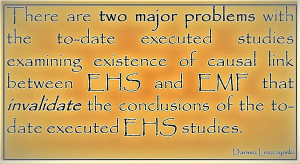On October 14th, 2017, Finnish newspaper ‘Helsingin sanomat’, in its science pages, has published a story on the electromagnetic hypersensitivity (EHS), with a lengthy title: “Nocebo effect explains why some people get symptoms from electromagnetic fields or wind power: in experimenting, mere worry of side effects, caused the volunteers to get symptoms” (in Finnish: Nosebovaikutus selittää, miksi jotkut saavat oireita sähköstä tai tuulivoimasta: kokeessa pelkkä sivuvaikutuksilla pelottelu sai koehenkilöt oireilemaan).
In the article, the journalist with the assistance of some scientists, came to the conclusion that EHS does not exist, it is not caused by the exposures to electromagnetic fields (EMF) and it is only an “imagination” of some people. This “imagination”, as it was concluded, was the sole cause of the negative health symptoms experienced by self-diagnosed EHS persons.
In short, the article in the ‘Helsingin sanomat’ made readers to understand that EHS is just a “delusion”.
The ‘Helsingin sanomat’ story on EHS was prompted by the publication of research report in the renowned ‘Science’ journal: “Interactions between brain and spinal cord mediate value effects in nocebo hyperalgesia”. The ‘Science’ article was dealing solely with the nocebo, it did not deal at all with possible implications of nocebo effect for the EHS. In the abstract of the study the authors stated:
“Value information about a drug, such as the price tag, can strongly affect its therapeutic effect. We discovered that value information influences adverse treatment outcomes in humans even in the absence of an active substance. Labeling an inert treatment as expensive medication led to stronger nocebo hyperalgesia than labeling it as cheap medication. This effect was mediated by neural interactions between cortex, brainstem, and spinal cord. In particular, activity in the prefrontal cortex mediated the effect of value on nocebo hyperalgesia. Value furthermore modulated coupling between prefrontal areas, brainstem, and spinal cord, which might represent a flexible mechanism through which higher-cognitive representations, such as value, can modulate early pain processing.”
In short, as also stated in the commentary accompanying publication of this research, the study suggests that nocebo affects nervous system:
“…spinal cord regions associated with pain response also showed more activation in the “expensive” cream group, suggesting it wasn’t all in the volunteers’ heads…”.
Meaning the symptoms experienced in response to nocebo are not pure imagination but have physiological basis. Our perceptions can and do affect physiology of our bodies.
This is a very interesting observation but using it as a scientific proof to claim that EHS does not exist is incorrect.
The EHS is only a self-diagnosed ailment. There are no tests to objectively determine whether person has or has not an EHS. However, the self-diagnosed EHS persons experience variety of symptoms that impact in negative way on their quality of life and there is an agreement that the symptoms are real. What is not agreed upon is what the cause of these symptoms is.
Some scientists claim that sufficient research has been done, that scientists looked everywhere and that the causal link between EHS and EMF exposures does not exist. Of this opinion are WHO EMF Project, ICNIRP, SCENIHR, ICES and, closely in their footsteps, the telecom industry and governments. As I pointed out in my earlier writings, At STUK in Finland, it was strictly forbidden, by then Research Director, to even think of doing research on EHS and, when I attempted to persuade STUK that the EHS research has a merit, I was reprimanded and my loyalty to STUK was questioned.
In my opinion the claim of the “sufficient” research on EHS that looked “everywhere” is utterly false and shows poor scientific judgement.
 There are two major problems with the to-date executed studies examining existence of causal link between EHS and EMF that invalidate the conclusions of the to-date executed EHS studies:
There are two major problems with the to-date executed studies examining existence of causal link between EHS and EMF that invalidate the conclusions of the to-date executed EHS studies:
These two above mentioned major reasons clearly indicate that the to-date executed EHS studies are simply worthless in deciding whether there exists, or not, any causal link between EHS and EMF.
Claim that scientists looked “everywhere” and found no EHS is completely false. Thus far, scientists have done just a set of subjective “feelings” studies that are absolutely insufficient as proof of non-existence of EHS. What has not been done are studies of human physiology when exposed to EMF that would provide objective data. We should look for molecular markers of human response to EMF. We should not focus on self-diagnosed EHS persons. We should use large groups of volunteers with and without self-diagnosed EHS, and look if there are any common molecular markers of response to EMF exposure and if there are any differences in the strength of the response. Without objective data from molecular studies we will never reliably answer the question of EHS and EMF.
Finally, to wrap-up, the ‘Helsingin sanomat’ should look at the issue of EHS with open mind and not slavishly follow the preconceived personal opinions of its journalists. Issue of EMF and health is very complex and there is a lot of lobbying from non-science entities. Without the scientific objectivity and the audiatur et altera pars approach and real scientific debate, ‘Helsingin sanomat’ science pages (tiede sivut) are becoming pseudo-scientific.
Advertisements Share this:




